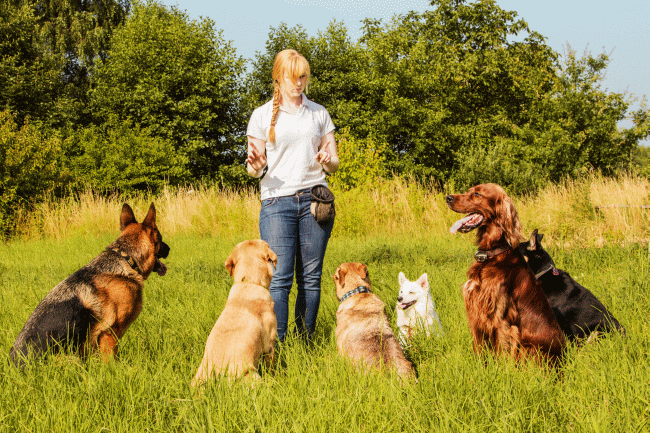Start Your Dog's Journey with Puppy Training That Builds Trust and Respect
Start Your Dog's Journey with Puppy Training That Builds Trust and Respect
Blog Article
Transform Your Dog's Actions With Proven Training Techniques
Changing your pet's actions requires a nuanced understanding of their specific qualities and requirements, as well as the application of proven training methods. Uniformity in your training technique not only enhances obedience yet additionally cultivates a deeper bond of trust and regard between you and your pet.

Understanding Dog Habits
Understanding dog habits is crucial for efficient training and interaction in between humans and their canine buddies. Dogs, as social animals, display a series of habits affected by genetics, setting, and experiences. Acknowledging these actions helps proprietors tailor their training approaches to satisfy the certain demands of their dogs.
Secret elements of dog habits consist of body movement, articulations, and social communications. For example, a wagging tail commonly indicates excitement, while a decreased head might signify submission or worry. Understanding these signals can assist proprietors analyze their pet's mood and react appropriately. Additionally, socialization plays a critical duty in shaping behavior; pets that communicate positively with different individuals and other animals are typically much more well-adjusted and adaptable.
In addition, recognizing stress and anxiety signals-- such as pacing, panting, or evasion behaviors-- can prevent rise into more significant concerns. Owners that are attuned to their dog's actions can produce a caring and risk-free environment, cultivating depend on and enhancing the training procedure. Eventually, a deep understanding of canine behavior lays the structure for a harmonious partnership and efficient training outcomes, making certain both pet dogs and their owners prosper together.
Positive Support Techniques
Favorable reinforcement methods are widely acknowledged as one of one of the most effective techniques for training dogs, promoting a favorable discovering setting. This approach involves rewarding wanted behaviors with deals with, praise, or play, therefore encouraging the pet to repeat those habits (Dog training). Unlike vindictive techniques, favorable reinforcement develops trust fund and strengthens the bond in between the trainer and the canine
To apply favorable reinforcement efficiently, timing is crucial. Benefits must be offered right away adhering to the desired actions to aid the dog make the connection. Consistency is likewise necessary; making use of the exact same commands and benefits assists the pet understand what is expected. Furthermore, differing the benefits can maintain the pet involved. For instance, rotating in between deals with, playthings, and spoken appreciation can keep rate of interest and inspiration.
It is very important to note that favorable support is not regarding bribery; instead, it has to do with strengthening etiquette. Over time, as the pet finds out to associate details activities with positive outcomes, the regularity of benefits can be slowly minimized, transitioning to spoken appreciation or recurring rewards. This method not only encourages obedience yet likewise promotes a confident and pleased dog, making training an extra delightful experience for both celebrations entailed.
Dealing With Usual Problems
Addressing typical issues during canine training is important for ensuring a unified and successful connection in between the pet dog and its proprietor. Lots of dog owners experience behavioral difficulties, such as excessive barking, leaping, and chain pulling. Understanding the origin triggers of these actions is vital for effective training.
To alleviate this, supply ample physical exercise, psychological excitement, and possibilities for social communication with both human beings and various other dogs. Educating the pet dog to sit upon welcoming can reroute this behavior positively.
Leash pulling is another prevalent issue, frequently arising from a pet dog's eagerness to check out. Using appropriate chain taking care of strategies, incorporated with training methods that urge loose-leash strolling, can substantially boost this actions.
In enhancement, concerns like source safeguarding or separation anxiety need customized techniques. Progressive desensitization and counter-conditioning can be efficient in dealing with these difficulties. By identifying and proactively handling these common issues, pet proprietors can cultivate a much more satisfying training experience and enhance the bond with their canine companions.
Uniformity in Training
Consistency is a foundation of efficient dog training, as it develops a clear framework for the pet dog to understand actions and expectations. When benefits, commands, and cues are used uniformly, pets can a lot more readily realize what is needed of them. Irregular training can bring about complication, resulting in unfavorable behaviors that irritate both the dog and the instructor.
To achieve uniformity, it is vital that all participants of the household follow the same training techniques. Utilizing the very see this same verbal hints and hand signals guarantees that the pet dog obtains uniform messages. Furthermore, the timing of improvements and benefits must be consistent; immediate reinforcement boosts the likelihood that the pet dog will certainly link the actions with the result.
Routine method sessions, coupled with structured schedules for feeding, strolling, and play, assistance pet dogs expect and understand their environment, making them more responsive to training. Inevitably, uniformity promotes a sense of safety and security and count on, empowering pets to learn a lot go to my site more properly.
Structure a Strong Bond
Just how can promoting a solid bond between a pet and its owner boost the training experience? When a canine really feels safe in its link with its owner, it is extra likely to show positive habits and be receptive to finding out.

In addition, a well-established link can reduce stress and anxiety and behavior problems, as canines are less likely to act out when they feel recognized and looked after. Focusing on the growth of a solid bond not only improves the training experience but also adds to a happier and much more well-adjusted dog. Inevitably, the trip of training transforms right into a joint partnership, bring about lasting behavioral enhancements.
Final Thought

Proprietors that are attuned to their dog's behavior can produce a caring and secure setting, fostering count on and improving the training procedure. Inevitably, a deep understanding of canine actions lays the foundation for a harmonious connection and efficient training results, guaranteeing both dogs and their proprietors thrive together.
Attending to usual concerns during canine training is necessary for guaranteeing a effective and harmonious connection between the pet and its proprietor (Dog training).Consistency is a keystone of effective pet training, as it establishes a clear framework for the canine to recognize habits and assumptions.In verdict, transforming a dog's behavior via confirmed training techniques needs an understanding of canine habits, the application of positive support strategies, and an emphasis on consistency
Report this page